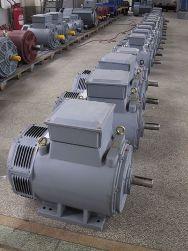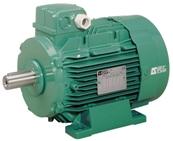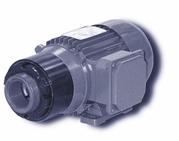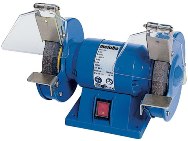Choice of electric motor
 Conditions for choosing an electric motor
Conditions for choosing an electric motor
The choice of one of the catalog types of electric motors is considered correct if the following conditions are met:
a) the most complete correspondence of the electric motor with the working machine (drive) in terms of mechanical properties. This means that the electric motor must have such a mechanical characteristic that it can provide the drive with the necessary values of speed and acceleration both during operation and at start-up;
b) maximum use of the power of the electric motor during operation. The temperature of all active parts of the electric motor in the most severe operating modes should be as close as possible to the heating temperature determined by the norms, but not exceed it;
c) compatibility of the electric motor with the drive and environmental conditions in terms of design;
d) compliance of the electric motor with the parameters of its power network.

a) the name and type of mechanism;
b) the maximum power of the drive shaft of the mechanism, if the mode of operation is continuous and the load is constant, and in other cases - graphs of changes in power or moment of resistance as a function of time;
c) the speed of rotation of the drive shaft of the mechanism;
d) the method of articulation of the mechanism with the shaft of the electric motor (in the presence of gears, the type of transmission and the transmission ratio are indicated);
e) the magnitude of the initial torque that must be provided by the electric motor on the drive shaft of the mechanism;
(f) the speed control limits of the drive mechanism, showing the upper and lower speed values and the corresponding power and torque values;
(g) the nature and quality (smoothness, gradation) of the required speed control;
(h) frequency of starting or engaging the drive within one hour; i) environmental characteristics.
The selection of an electric motor based on consideration of all conditions is carried out according to the catalog data.
For widespread mechanisms, the selection of an electric motor is greatly simplified due to the data contained in the relevant information of the manufacturers, and comes down to specifying the type of electric motor in relation to the parameters of the network and the nature of the environment.
Selection of electric motors by power

a) according to the nominal mode of operation;
b) through changes in the amount of energy consumed.
The following operating modes are distinguished:
a) long (long), when the working period is so long that heating of the electric motor reaches its stable value (for example, for pumps, conveyor belts, fans, etc.);
b) short-term, when the duration of the operating period is insufficient for the electric motor to reach the heating temperature corresponding to the given load, and the shutdown periods, on the contrary, are sufficient to cool the electric motor to the ambient temperature. Electric motors with a wide variety of mechanisms can work in this mode;
c) with interruptions - with a relative duty cycle of 15, 25, 40 and 60% with a duration of one cycle not exceeding 10 minutes (for example, for cranes, some metal-cutting machines, single-station welding engines-generators, etc.).
Depending on the changes in the energy consumption value, the following cases differ:
a) constant load when the amount of power consumed during operation is constant or has slight deviations from the average value, such as for centrifugal pumps, fans, constant air flow compressors, etc.;
b) variable load, when the amount of power consumed changes periodically, such as for excavators, cranes, some metal-cutting machines, etc.;
c) pulsating load when the amount of power consumed changes continuously, such as reciprocating pumps, jaw crushers, screens, etc.
Engine power must meet three conditions:

b) sufficient overload capacity;
c) sufficient starting torque.
All electric motors are classified into two main groups:
a) for long-term work (without limitation of the duration of inclusion);
b) for intermittent operation with switching times of 15, 25, 40 and 60%.
For the first group, the catalogs and passports show the continuous power that the electric motor can develop for an indefinite long time, for the second group — the power that the electric motor can develop, working intermittently for an arbitrary long time with a certain turn-by-duration.
Correctly selected in all cases is considered such an electric motor, which, working with the load according to the schedule determined by the working machine, reaches the full permissible heating of all its parts. The choice of electric motors with the so-called "Power reserve", based on the largest possible load according to the schedule, leads to underutilization of the electric motor, and therefore to increased capital costs and operating costs due to reduced power factors and efficiency.
Excessive increase in engine power can also lead to jerks during acceleration.
If the electric motor must work for a long time with a constant or slightly changing load, then determining its power is not difficult and is carried out according to formulas that usually include empirical coefficients.
It is much more difficult to choose the power of electric motors in other modes of operation.
The short-term load is characterized by the fact that the periods of inclusion are short, and the breaks are sufficient for the complete cooling of the electric motor. In this case, it is assumed that the load on the electric motor during the switching periods remains constant or almost constant.
In order for the electric motor to be used correctly for heating in this mode, it is necessary to choose it so that its continuous power (indicated in the catalogs) is less than the power corresponding to the short-term load, i.e. the electric motor has a thermal overload during the periods of its short-term operation.
If the periods of operation of the electric motor are significantly less than the time required for its complete heating, but the pauses between the periods of switching on are significantly shorter than the time of complete cooling, then there is repeated short-term loading.
In practice, two types of such work should be distinguished:
a) the load during the period of operation is constant in magnitude, and therefore its graph is depicted with rectangles alternating with pauses;
b) the load during the working period changes according to a more or less complex law.
In both cases, the problem of choosing an electric motor in terms of power can be solved both analytically and graphically. Both methods are quite complicated, so a simplified method of equivalent magnitude is recommended, which includes three methods:
a) rms current;
b) root mean square power;
(c) root mean square moment.
Checking the mechanical overload capacity of the electric motor
 After selecting the power of the electric motor according to the heating conditions, it is necessary to check the mechanical overload capability of the electric motor, that is, make sure that the maximum load torque according to the schedule during operation and the starting torque will not exceed the maximum torque value moment according to the catalog.
After selecting the power of the electric motor according to the heating conditions, it is necessary to check the mechanical overload capability of the electric motor, that is, make sure that the maximum load torque according to the schedule during operation and the starting torque will not exceed the maximum torque value moment according to the catalog.
In asynchronous and synchronous electric motors, the value of the permissible mechanical overload is determined by their overturning electromagnetic moment, upon reaching which these electric motors stop.
The product of the maximum torques with respect to the rating should be 1.8 for three-phase asynchronous motors with slip rings and at least 1.65 for the same squirrel-cage motors. The multiple of the maximum torque of a synchronous electric motor must also be at least 1.65 at rated voltage, frequency and excitation current, with a power factor of 0.9 (at leading current).
Practically, asynchronous and synchronous electric motors have a mechanical overload capacity of up to 2-2.5, and in some special electric motors this value increases to 3-3.5.
The permissible overload of DC motors is determined by the operating conditions and according to GOST is from 2 to 4 per torque, the lower limit applies to electric motors with parallel excitation, and the upper limit to electric motors with series excitation.
If the supply and distribution networks are sensitive to the load, then the mechanical overload capacity must be checked, taking into account the voltage losses in the networks.
For asynchronous short-circuit and synchronous electric motors, the starting torque multiple must be at least 0.9 (relative to nominal).
In fact, the initial torque multiplier in double-squirrel-cell and deep-groove electric motors is much higher and reaches 2-2.4.
When choosing the power of the electric motor, it should be taken into account that the switching frequency affects the heating of the electric motors.The permissible switching frequency depends on the normal slip, the torque of the rotor flywheel and the frequency of the inrush current.
Asynchronous electric motors of normal types do not allow a load from 400 to 1000, and electric motors with increased slip - from 1100 to 2700 starts per hour. When starting under load, the permissible number of starts is significantly reduced.
The starting current of electric motors with a squirrel-cage rotor is large, and this circumstance in the conditions of frequent starts and especially with increased acceleration time is important.
Unlike electric motors with a phase rotor, in which part of the heat generated during starting is released in the rheostat, i.e. outside the machine, in squirrel-cage engines, all the heat is released into the machine itself, which causes its increased heating. Therefore, the choice of the power of these electric motors must be made taking into account the heating during multiple starts.
